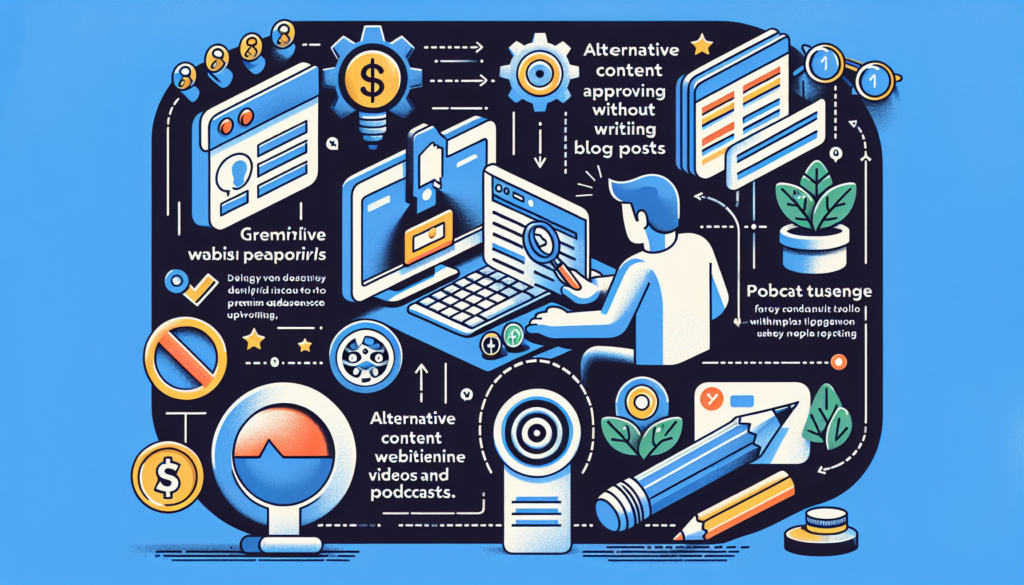Are you looking to monetize your website through Google AdSense but don’t have the time or interest to write lengthy blog posts? Well, you’re in luck! In this article, you will discover the secrets to getting Google AdSense approval without having to write a single blog post. Whether you’re a busy entrepreneur or simply looking for an alternative way to generate income from your website, these tips and tricks will provide you with a shortcut to Google AdSense approval. So, let’s get started and unlock the potential of your website like never before!
Choosing the Right Platform
Understanding the Requirements
When it comes to choosing the right platform for your online content, it is essential to understand your requirements. Consider the type of content you want to create and share with your audience. Are you primarily focused on video content or do you also plan to have a website? Understanding your goals and needs will help you make an informed decision.
Exploring Alternative Platforms
Before settling on a specific platform, take the time to explore alternative options. There are numerous platforms available, each with its own features and benefits. Look into platforms like Vimeo, Dailymotion, and Twitch to see if they align with your content and audience preferences. By exploring different platforms, you can find the one that best suits your needs.
Considering Self-Hosted Options
While using platforms like YouTube or Vimeo may be convenient, consider the benefits of self-hosting your content. Self-hosting gives you complete control over your content and allows you to customize your website to your liking. Research different self-hosted options, such as WordPress, Drupal, or Joomla, and consider whether this route is more suitable for you.
Using YouTube
YouTube is one of the most popular platforms for sharing video content. It offers a wide range of features and benefits for content creators. With billions of active users, YouTube provides a vast audience base for your videos. Additionally, YouTube’s monetization program, known as the YouTube Partner Program, allows you to earn money from your videos through advertisements. Consider utilizing YouTube as a platform to reach a large audience and potentially generate income from your content.
Creating Engaging Content
Focusing on Video Content
To capture the attention of your audience, it is crucial to focus on creating engaging video content. Plan and create videos that are informative, entertaining, and visually appealing. Consider the interests and preferences of your target audience and tailor your content accordingly. Engaging video content will keep viewers coming back for more and increase the chances of them sharing your videos with others.
Optimizing Video Titles and Descriptions
The title and description of your videos play a significant role in attracting viewers to your content. Optimize your video titles by using relevant keywords that accurately describe the content of your videos. Likewise, write compelling and concise descriptions that entice viewers to click and watch. Including relevant keywords in your video titles and descriptions can also improve your search engine rankings.
Utilizing YouTube Thumbnails
Thumbnails are the first visual representation of your videos that viewers see. Use eye-catching and high-quality thumbnails to grab the attention of potential viewers. Design thumbnails that accurately represent the content of your video and make them visually appealing. Custom thumbnails are a great way to make your videos stand out in search results and increase click-through rates.
Developing a Video Schedule
Consistency is key when it comes to creating engaging content. Develop a video schedule and stick to it. This will help you maintain a regular presence and keep your audience engaged. Plan your videos in advance, create a content calendar, and set realistic goals for the frequency of your uploads. By adhering to a video schedule, you can build a loyal subscriber base that eagerly anticipates your new content.

Designing a Professional Website
Selecting an Attractive Theme
When designing a professional website to complement your video content, selecting an attractive theme is essential. Choose a theme that aligns with the overall style and tone of your content. Look for themes that offer customization options and are optimized for performance. An attractive theme will create a positive first impression and encourage visitors to explore your website further.
Customizing the Site Layout
Make your website unique and visually appealing by customizing the site layout. Use the customization options provided by your chosen platform or theme to personalize the design. Pay attention to details such as colors, fonts, and images to create a cohesive and professional look. A well-designed site layout will enhance the user experience and reflect the quality of your content.
Optimizing for Mobile Devices
In today’s mobile-centric world, it is crucial to optimize your website for mobile devices. Ensure that your chosen platform or theme is mobile-responsive, meaning it automatically adjusts to different screen sizes and resolutions. Test your website on various devices to ensure a smooth and user-friendly experience for your mobile audience. By optimizing for mobile devices, you can reach a wider audience and keep visitors engaged.
Including Essential Pages
To create a comprehensive and professional website, include essential pages that provide valuable information to your visitors. Some pages to consider including are an about page, contact page, and privacy policy page. The about page can share your story and build trust with your audience, while the contact page allows visitors to reach out to you. The privacy policy page demonstrates your commitment to protecting user data and ensures compliance with privacy regulations.
Enhancing User Experience
Improving Website Navigation
A user-friendly website is essential for keeping visitors engaged and encouraging them to explore further. Improve website navigation by using intuitive menus and clear links. Organize your content into logical categories to help visitors find what they are looking for easily. Make sure your navigation is consistent across all pages of your website for a seamless browsing experience.
Including Relevant Sections
To enhance user experience, include relevant sections on your website that provide additional value to your visitors. Consider adding sections such as a blog, resources, or FAQs that provide helpful information related to your content. These sections can improve engagement and keep visitors on your website for longer periods of time.
Utilizing Call-to-Action Buttons
Guide your visitors to take specific actions on your website by utilizing call-to-action buttons strategically. Whether you want them to subscribe to your newsletter, watch a specific video, or make a purchase, use visually appealing and well-placed call-to-action buttons to encourage desired actions. These buttons can significantly impact user engagement and conversion rates.
Optimizing Page Load Speed
A fast-loading website is crucial for providing a positive user experience. Optimize your website’s page load speed by optimizing images, minimizing code, and utilizing caching techniques. A slow-loading website can be frustrating for visitors and negatively impact user engagement. Regularly test and optimize your website’s performance to ensure a smooth browsing experience for your audience.

Applying for Google AdSense
Understanding AdSense Policies
Before applying for Google AdSense, it is essential to understand their policies to ensure compliance. Review the AdSense Program Policies thoroughly to ensure your content meets their guidelines. Pay attention to policies regarding prohibited content, copyright infringement, and adult content. Familiarize yourself with these policies to avoid any potential issues with your AdSense account.
Creating an AdSense Account
To start monetizing your website or YouTube channel with Google AdSense, you need to create an AdSense account. Visit the AdSense website and follow the step-by-step instructions to sign up. Provide accurate and complete information during the registration process to avoid any delays in the approval process. Once your account is created, you can begin the application process.
Linking AdSense with Website or YouTube
After creating your AdSense account, you need to link it to your website or YouTube channel to start earning money from ads. Follow the instructions provided by Google to generate the necessary code or integrate the AdSense plugin into your website. For YouTube, link your AdSense account to your YouTube channel by going to the YouTube Partner Program settings. This step is crucial for enabling ad monetization on your content.
Implementing AdSense Code
To display ads on your website or YouTube channel, you need to implement the AdSense code correctly. If you are using a website platform like WordPress, you can utilize plugins or widgets provided by AdSense to easily integrate the code. For YouTube, AdSense ads are automatically displayed on eligible videos once your account is linked. Make sure the AdSense code is implemented correctly to ensure proper ad placement and maximize revenue potential.
Providing Authentic Information
Validating Personal Details
When applying for Google AdSense, it is crucial to provide authentic and accurate personal details. This includes your name, address, and contact information. Google may verify this information during the approval process, so ensure that the information you provide is genuine and matches your official identification documents.
Setting up Correct Payment Information
To receive payments from Google AdSense, set up correct payment information in your AdSense account. This includes providing accurate bank account details or selecting an alternative payment method, such as checks or wire transfers. Double-check your payment information to avoid any delays or errors in receiving your earnings.
Ensuring Accurate Tax Information
Google AdSense requires you to provide accurate tax information to comply with tax regulations. Depending on your location and tax jurisdiction, you may need to fill out tax forms such as a W-9 or W-8BEN. Review the tax guidelines provided by Google and ensure accurate and complete information is provided for tax purposes.
Verifying Website Ownership
To prevent misuse and unauthorized access, Google AdSense requires website verification during the approval process. Verify your ownership of the website by following the instructions provided by Google. This typically involves adding a meta tag or uploading an HTML file to your website’s root directory. Successful verification is necessary for your AdSense application to move forward.

Optimizing Ad Placement
Analyzing Heatmap Data
Optimizing the placement of ads on your website requires understanding user behavior and preferences. Analyze heatmap data to identify areas of high user engagement on your website. Heatmaps provide visual representations of where users tend to focus their attention. Use this data to strategically place ads where they are more likely to be seen and clicked on, maximizing your revenue potential.
Using Responsive Ad Units
With the increasing use of mobile devices, it is important to utilize responsive ad units. These ad units automatically adjust their size and layout to fit different screen sizes and resolutions. By using responsive ad units, you ensure that your ads are displayed optimally across various devices, providing a seamless user experience and improving the likelihood of clicks.
Balancing Content and Ads
Finding the right balance between content and ads is crucial for maintaining a positive user experience. While ads can generate revenue, excessive or intrusive ads can be off-putting to visitors. Ensure that your website is not overly cluttered with ads and that the placement is strategic. Prioritize providing valuable content to your audience while strategically incorporating ads to drive revenue.
Monitoring Ad Performance
Optimizing ad placement requires continuous monitoring and analysis of ad performance. Regularly review your AdSense account to analyze metrics such as click-through rates, impressions, and earnings. Identify any patterns or trends and make adjustments to your ad placement accordingly. By monitoring ad performance, you can identify areas for improvement and maximize your revenue potential.
Implementing SEO Techniques
Conducting Keyword Research
To improve your website’s visibility and attract organic traffic, conduct keyword research. Identify relevant keywords that are frequently searched by your target audience. Use keyword research tools to find high-ranking and low-competition keywords. Incorporate these keywords naturally into your website’s content, titles, and meta tags to maximize your SEO efforts.
Crafting Compelling Meta Tags
Meta tags play a crucial role in improving your website’s search engine rankings. Craft compelling and concise meta titles and descriptions that accurately represent the content of your web pages. Incorporate relevant keywords where appropriate to increase your chances of appearing in search engine results. Well-crafted meta tags can improve click-through rates and attract more organic traffic to your website.
Optimizing Heading Tags
Heading tags, such as H1, H2, and H3, provide structure and hierarchy to your website’s content. Use heading tags to highlight important keywords and key phrases. This not only improves the readability and organization of your content but also signals search engines about the relevance of your content. Properly optimized heading tags can positively impact your website’s SEO.
Optimizing Images
Optimizing images on your website is crucial for both user experience and SEO. Compress images to reduce file sizes and improve page load speed. Use descriptive filenames and alt text to provide context and improve accessibility. Additionally, include relevant keywords in image file names and alt text to optimize your images for search engine visibility.

Promoting Social Media Engagement
Sharing Videos on Social Platforms
Leverage the power of social media by sharing your videos on various platforms. Create profiles or pages on platforms like Facebook, Twitter, Instagram, and LinkedIn. Regularly share your videos with engaging captions and appropriate hashtags to reach a wider audience. Encourage your followers to like, comment, and share your videos to increase engagement and expand your reach.
Encouraging Likes, Comments, and Shares
Engagement is key in building a loyal community of viewers. Encourage your audience to like, comment, and share your videos. Ask questions or create prompts at the end of your videos to encourage viewers to leave comments and engage with your content. Respond to comments and engage with your audience to foster a sense of community and loyalty.
Building a Community of Subscribers
A strong subscriber base is essential for long-term success. Encourage viewers to subscribe to your YouTube channel or sign up for email updates on your website. Offer incentives such as exclusive content, early access, or giveaways to entice viewers to become subscribers. Regularly communicate with your subscribers and provide them with valuable content to maintain their loyalty.
Cross-Promoting Content
Cross-promotion is a powerful strategy to expand your reach and increase engagement. Promote your website on your YouTube channel and vice versa. Additionally, include links or embedded videos in your blog posts to encourage readers to watch your videos. By cross-promoting your content across different platforms, you can attract new viewers and drive traffic to your website or YouTube channel.
Ensuring Policy Compliance
Monitoring AdSense Policies
To maintain a successful and compliant AdSense account, it is essential to regularly monitor AdSense policies. Google periodically updates its policies, and it is your responsibility to stay informed and adapt your content accordingly. Review policy updates and make any necessary changes to your content to ensure compliance. Failure to adhere to AdSense policies may result in potential penalties or account suspension.
Avoiding Prohibited Content
Google AdSense has strict guidelines regarding prohibited content. Ensure that your content does not violate any of these guidelines. Avoid publishing or promoting content related to adult themes, violence, hate speech, or illegal activities. Review the AdSense Program Policies thoroughly and consistently monitor your content to maintain compliance.
Respecting Copyrighted Material
Respecting copyright laws and intellectual property rights is crucial when creating content. Do not use copyrighted material, such as images, videos, or music, without proper authorization or licensing. Create original content or use royalty-free resources to avoid any legal issues or violations. Respecting copyright laws not only ensures compliance but also helps establish a trustworthy and reputable online presence.
Reviewing and Understanding Policy Updates
Google periodically updates its policies, and it is important to review and understand these updates. Policy changes may affect your content or monetization strategies. Stay informed by regularly checking for policy updates and reviewing the revised guidelines. Understanding policy updates ensures that your content remains compliant and your AdSense account stays in good standing.
In conclusion, successfully monetizing your online content through Google AdSense requires careful consideration of various factors. Choosing the right platform, creating engaging content, designing a professional website, enhancing user experience, and promoting social media engagement are all important aspects to consider. Additionally, understanding and adhering to AdSense policies, optimizing ad placement, implementing SEO techniques, and ensuring policy compliance are crucial for long-term success. By following these guidelines, you can increase your chances of obtaining and maintaining Google AdSense approval without solely relying on writing blog posts.

Paul is a digital marketing and blogging specialist who shares his knowledge and experience on his blog. He writes about topics such as SEO, PPC advertising, social media marketing, content marketing, email marketing, analytics and much more. Paul’s goal is to provide his readers with the information and resources they need to create and implement successful digital marketing campaigns and a profitable blog.
